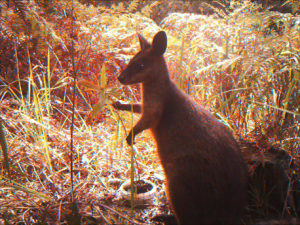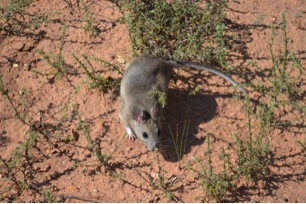Who will eat me and how fast will I be out-competed? Questions about the future for eucalyptus seedlings in a kangaroo world. Read more in Early View paper “Associational refuge in practice: can existing vegetation facilitate woodland restoration?” by Rebecca S. Stutz and co-workers. Below is their own summary of the study:
The characteristics of plant patches influence whether and how herbivores search for, detect and consume particular focal plants. Neighbouring plants may disrupt this foraging process at any phase, providing associational plant refuge for a focal plant. If we understand how and why this occurs, we may be able to improve revegetation efforts by planting strategically amongst existing vegetation to maximise their chances of escape from herbivory. We tested the capacity of existing vegetation in a degraded area of Booderee National Park, eastern Australia, to provide refuge for eucalypt seedlings from abundant mammalian herbivores. We quantified a suite of variables at large and small patch scales and used field cameras to confirm which herbivore species was responsible for seedling consumption.
Swamp wallabies were the principal browsers of seedlings. When they detected a seedling, they almost always decided to consume it, usually completely. At the larger patch scale, seedlings escaped browsing by swamp wallaby for longer in patches with fewer browsed plant species and those dominated by ferns rather than grasses. Higher understorey cover provided refuge for seedlings at the small patch scale. These characteristics are all consistent with disruption to the search and detection phases of the foraging process, and therefore the occurrence of associational plant effects. Lower canopy cover at the large scale also reduced browsing but the mechanism may be through its influence on microclimate, probability of finding seedlings below-canopy, or perceived predation risk. Our study demonstrates that existing patch characteristics can both provide associational plant refuge and influence patterns of herbivore foraging more generally.








